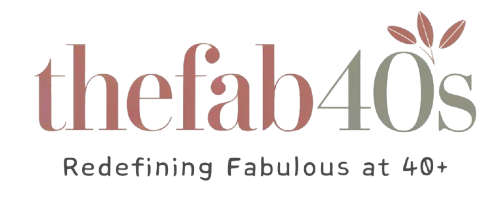Natural Hair Care Tips for Healthy, Beautiful Results
Embracing your hair’s natural beauty is a rewarding journey. It leads to healthier, more vibrant locks. Natural hair care uses gentle, nourishing ingredients to strengthen and protect your hair. It avoids harsh chemicals that can strip away its essential oils and nutrients.
By understanding your unique hair type and texture, you can achieve stunning results. Incorporating the right natural products and techniques is key. This guide will help you unlock your hair’s full potential.
Discover the power of avocado, olive oil, and honey. Also, maintain a balanced diet rich in hair-healthy nutrients. These Hair Care Tips and Haircare Routine insights will help you cultivate Healthy Hair. Your hair will shine with natural radiance.
Understanding Your Hair Type and Texture
Healthy, beautiful hair starts with knowing your hair type and texture. Hair falls into four main categories: straight (type 1), wavy (type 2), curly (type 3), and coily (type 4). Each type has subcategories, from A to C, based on the wave, curl, or coil size.
Knowing your hair type is key for choosing the right Hair Styling Techniques and products. For example, type 1 hair gets oily fast, so it needs lightweight, oil-free products. On the other hand, type 4 hair needs lots of moisture and gentle care to avoid breakage.
Identifying Wave, Curl, and Coil Patterns
Look closely at your hair strands to find your specific pattern:
- Type 1: Stick-straight with little to no wave
- Type 2: Subtle waves with an “S” shape
- Type 3: Defined, springy curls in a more uniform shape
- Type 4: Tightly coiled, zigzag patterns that form a dense, kinky texture
Many people have different hair types on different parts of their head. So, it’s important to look at the overall pattern and texture.
How Hair Type Affects Care Requirements
Knowing your hair type guides the Hair Styling Techniques and products you should use. Straight hair might need more washing to control oil. Curly and coily textures, however, need richer moisturizers and gentler detangling to prevent breakage.
Accepting your natural hair type and texture is the first step to your best look. With the right Hair Damage Prevention strategies, you can have a beautiful, confident, and easy-to-maintain style.
Essential Hair Care Tips for Daily Maintenance
Keeping your hair healthy is key to avoiding damage and getting beautiful locks. A few simple steps each day can nourish your hair and keep it looking great.
Begin by gently detangling your hair. Use a wide-tooth comb or your fingers, starting from the ends. This method reduces breakage and keeps your hair’s natural texture. Try to avoid too much handling, as it can cause frizz and damage.
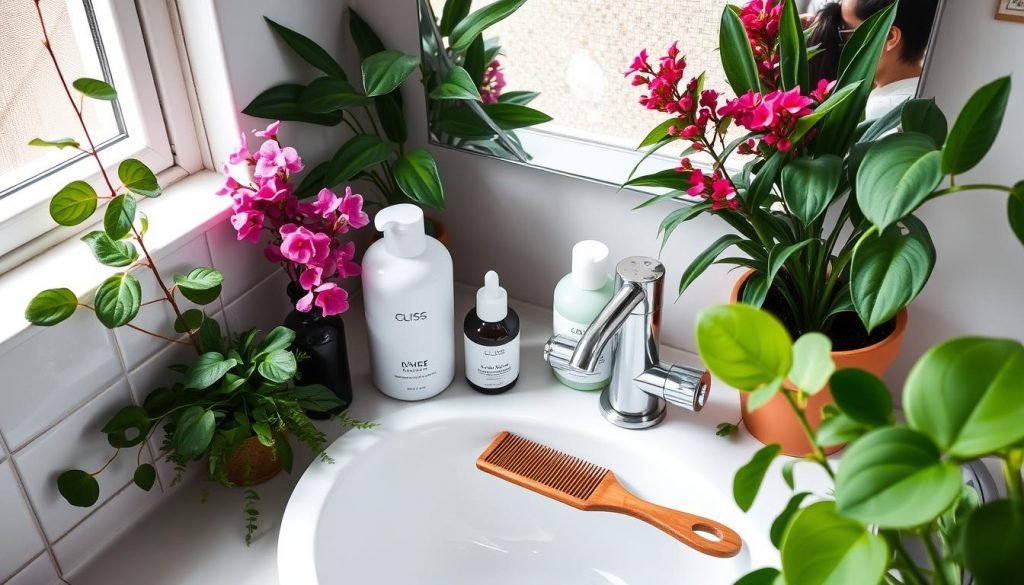
When you sleep, protect your hair from friction and dryness. Use a satin or silk pillowcase or wrap it in a soft hair wrap. This helps prevent tangles and keeps moisture in your hair all night.
To prevent hair damage, try protective styles like braids, twists, or buns. These styles reduce handling and protect your hair’s ends from environmental stress.
Finally, use heat styling tools less often. When you do, always apply a heat protectant product. By following these Haircare Routine tips, you can keep your hair healthy and vibrant every day.
The Science of Hair Moisture and Hydration
Maintaining Healthy Hair begins with understanding hair moisture and hydration. The right balance between water-based and oil-based products is crucial. This balance helps lock in moisture and prevents Frizzy Hair Solutions.
Water-Based vs. Oil-Based Products
Water-based products hydrate hair by providing moisture directly. Oil-based products seal in moisture, keeping it from evaporating. Using both types strategically is key to achieving hydration balance.
The LOC/LCO Moisture Method
The LOC (Liquid, Oil, Cream) or LCO (Liquid, Cream, Oil) method is widely used. It involves applying a liquid, then an oil, and finally a cream or butter. This method ensures your Healthy Hair stays hydrated all day.
Seasonal Moisture Adjustments
Adjusting your hair care routine with the seasons is vital. In colder, drier months, use more moisture-based products. Focus on the hair ends, which are usually driest, to prevent Frizzy Hair Solutions and keep hair healthy.
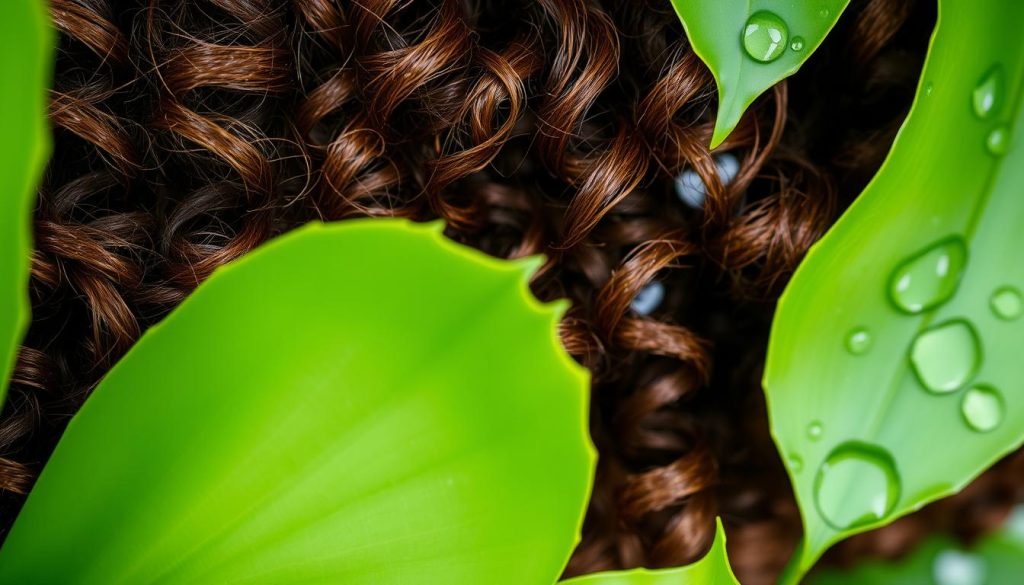
“Healthy hair starts from the inside out. Proper hydration is the key to maintaining strong, vibrant locks.”
Choosing Natural and Safe Hair Products
Choosing the right hair products is key to keeping your hair healthy and beautiful. Look for products with aloe vera, chamomile, and essential oils. Avoid harsh chemicals like sulfates, parabens, and phthalates. These can dry out your hair and scalp.
Always read the ingredient list carefully. Focus on the first 5-8 ingredients. Choose products with natural oils and butters like almond, coconut, avocado, and shea. Remember, “natural” isn’t always what it seems, so check the ingredients.
Using Natural Hair Products and Hair Treatments can greatly improve your hair’s health and look. By making smart choices, you can nourish and protect your hair. And you’ll avoid harmful chemicals.
- Opt for natural ingredients like aloe vera, chamomile, and essential oils
- Avoid harsh chemicals such as sulfates, parabens, and phthalates
- Read ingredient lists carefully, focusing on the first 5-8 ingredients
- Look for high-quality natural oils and butters like almond, coconut, avocado, and shea
- Verify that “natural” claims are accurate, as the term is not regulated in the cosmetics industry
“Investing in natural hair products can have a significant impact on the health and appearance of your hair.”
Gentle Detangling Techniques and Tools
Detangling your hair is key to keeping it healthy and looking great. But, you must do it carefully to avoid hair damage and breakage. The right tools and techniques help you gently remove tangles without harming your hair styling.
Wet vs. Dry Detangling Methods
Detangling your hair when it’s slightly damp or wet is better and gentler than when it’s dry. Using a detangling product can make combing easier. But, don’t detangle when your hair is very wet, as it’s more likely to break.
Proper Combing and Brushing Techniques
- Use a wide-tooth comb or your fingers to gently work through tangles, starting from the ends and working your way up to the roots.
- Avoid using small-toothed combs or brushes with close bristles, as they can lead to unnecessary breakage.
- Segment your hair into manageable sections to maintain organization and prevent overwhelm during the detangling process.
- Be patient and gentle throughout the detangling process, taking your time to prevent rushing and causing damage.
“Detangling your hair requires patience and a delicate touch. By using the right techniques and tools, you can keep your locks healthy and beautiful.”
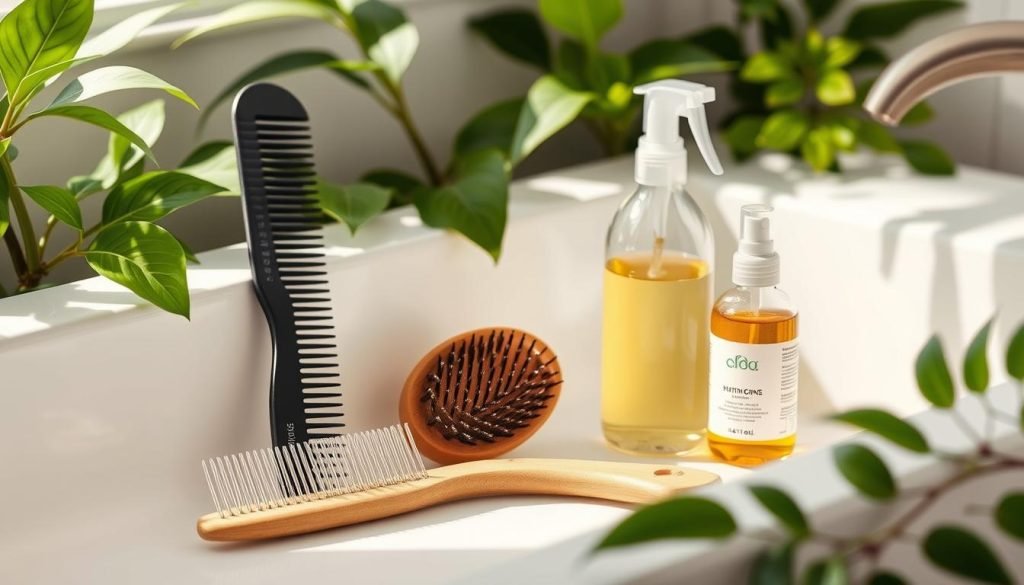
Regular trims, consistent hair care, and avoiding unnecessary friction can help reduce tangles and knots. This makes detangling easier and more effective. With a little care and attention, you can keep your hair healthy and beautiful.
Protective Styling Strategies
Protective styling is a big deal in natural hair care. These hairstyles protect your hair from the environment and reduce damage. Styles like buns, twists, braids, and cornrows shield your hair from harm.
Protective styling keeps your hair moist. It limits your hair’s contact with the outside world. This helps prevent dryness and breakage, making your hair healthier.
- Buns, twists, and braids are popular protective styles that offer a range of styling options to suit your preferences and hair type.
- Rotate your protective styles regularly to prevent stress on the hair and scalp, and avoid keeping a single style for too long.
- Incorporate specialized products like Mielle’s Mongongo Oil Pre-Shampoo Treatment to add moisture and condition your cuticles while in a protective style.
- Protect your edges by using a satin or silk scarf or bonnet at bedtime to prevent moisture loss and maintain the health of your hairline.
Choosing protective styling is smart for your hair. It helps your hair stay healthy and grow longer. Plus, it’s easy to maintain.
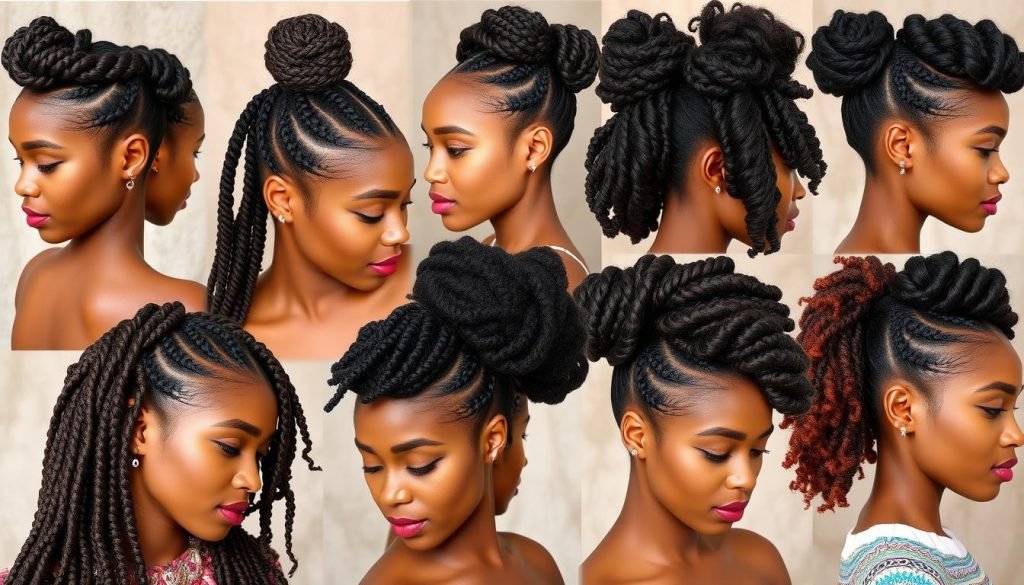
“Protective styling is a game-changer in the realm of natural hair care, shielding your strands against damage and promoting healthy growth.”
Natural Ingredients for Hair Health
Natural ingredients are becoming more popular for healthier, more beautiful hair. Natural Hair Products and Hair Treatments use plant-based components. They are gentler and more nourishing than traditional chemical formulas.
These natural wonders can solve many hair problems. They promote overall hair health.
Essential Oils and Their Benefits
Essential oils like tea tree, peppermint, and lavender are amazing for hair. Tea tree oil fights scalp issues like dandruff and oiliness. Peppermint oil boosts hair growth by improving circulation.
Lavender oil calms the scalp and helps prevent stress-related hair loss. It’s soothing and calming.
Plant-Based Hair Treatments
Try homemade hair treatments with avocado, olive oil, honey, and aloe vera. Avocado oil is full of fatty acids and vitamins. It deeply conditions and repairs damaged hair.
Olive oil adds shine and moisture to dry, brittle hair. Honey and aloe vera soothe the scalp. They help with dryness and irritation.
Using these Natural Hair Products and Hair Treatments can make your hair healthier and more vibrant. You won’t have to deal with harsh chemicals. Nature has the power to transform your hair.
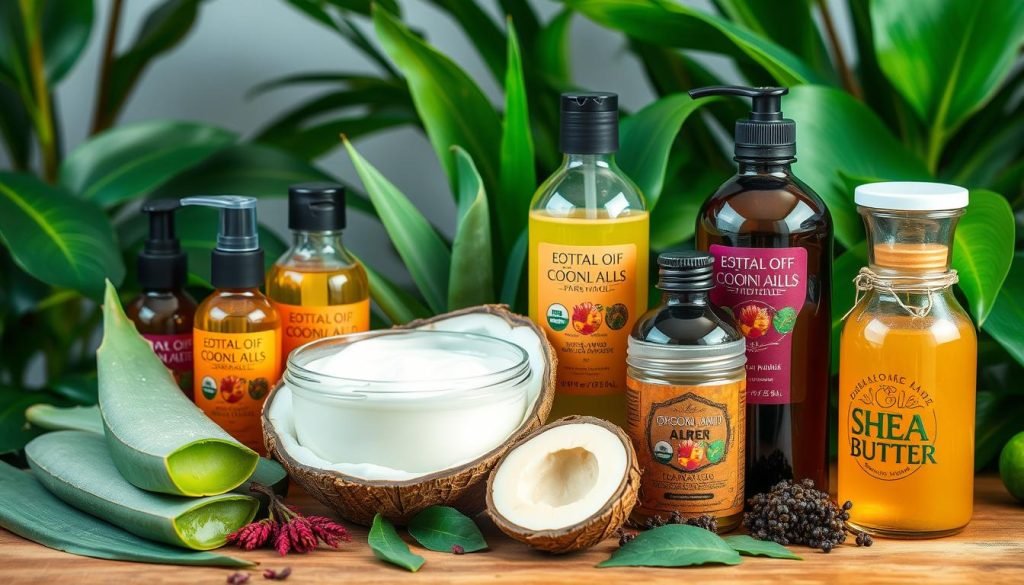
“The secret to healthy, beautiful hair is often found in nature’s bounty.” – Hair Care Expert, Jane Doe
Scalp Care and Maintenance
Keeping your scalp healthy is crucial for beautiful hair. The scalp has five layers and over 100,000 hair follicles. But, problems like dandruff and psoriasis can harm it, causing hair issues.
To fight these problems, use gentle, sulfate-free shampoos. They clean the scalp without taking away its natural oils. You can also try co-washing with creamy cleansers to moisturize the scalp.
If you have dandruff, use anti-fungal ingredients like ketoconazole. These ingredients help control flaky, itchy scalps. For psoriasis and eczema, treatments with salicylic acid or corticosteroids might be needed.
Scalp massages are also great. They improve blood flow and help hair grow. Using a water filter can also help, especially in areas with hard water.
By focusing on your scalp, you’ll get healthier hair. Try these tips and see your hair and scalp improve.
“A healthy scalp is the foundation for beautiful, strong hair. Invest in its care, and reap the rewards of a lustrous, confident look.”
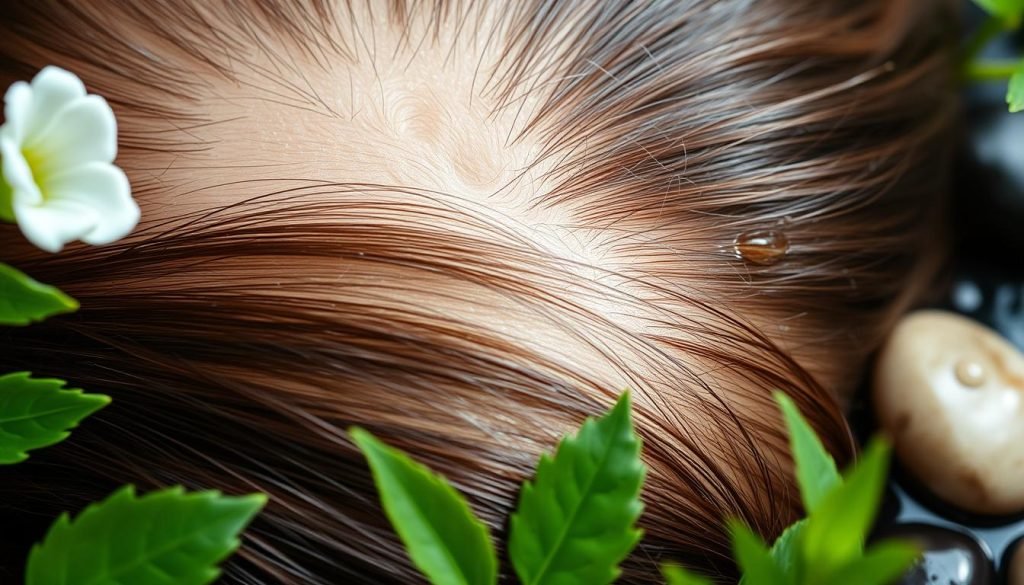
Washing and Conditioning Best Practices
Keeping your hair healthy is key to having vibrant, strong, and beautiful natural hair. Washing and conditioning are crucial steps. Here are some best practices to follow for the best results.
Frequency Guidelines
How often you wash your hair depends on your hair type and lifestyle. Here’s a general guideline:
- Wash oily or fine hair every 2-3 days.
- Wash normal to dry or coily/curly hair 1-2 times a week.
Adjust your washing schedule based on your activity level, product buildup, and the season. Washing too much can remove natural oils. Not washing enough can cause scalp problems and dull hair.
Product Application Methods
When using Haircare Routine products, use the right technique for the best results:
- Wet your hair with lukewarm water to loosen dirt and buildup.
- Apply a Natural Hair Products shampoo to your scalp, massaging gently with your fingertips.
- Rinse the shampoo well, making sure to remove all residue, especially at the back of your head and nape of your neck.
- Apply a moisturizing conditioner to the lengths and ends of your hair, avoiding the scalp area.
- Let the conditioner sit for a few minutes, then rinse with cool water to seal the hair cuticle.
Try co-washing (using a cleansing conditioner) between shampoo sessions for extra hydration. This is especially good for curly or dry hair.
“Proper hair washing and conditioning methods are essential for maintaining the health and vibrancy of your natural hair.”
Heat Styling Prevention and Protection
It’s important to reduce heat styling to keep your hair healthy. Always use a heat protectant and set your tools to the lowest temperature. Letting your hair air dry or gently blotting it with a microfiber towel helps too.
Try to use your hair’s natural texture and avoid heat styling. You can air-dry, braid, or use heatless curlers. This not only prevents damage but also makes your hair look great.
- Wait for hair to air dry before using hot styling tools.
- Adjust temperature settings on your hair dryer, straightener, or curling iron to the lowest effective level for your Hair Styling Techniques.
- Apply a heat-protective spray or serum before styling to create a barrier against heat damage.
- Give your hair a break from heat styling whenever possible, and experiment with heatless styling options.
- Incorporate deep conditioning treatments to replenish moisture and strengthen hair strands.
“Heat-styling can cause moisture loss by opening up the scales of hair strands, resulting in rough, dry, and dull hair.”
By focusing on Hair Damage Prevention and trying different Hair Styling Techniques, you can keep your hair healthy and stylish. Making a few changes can help you find the right balance between looking good and keeping your hair healthy.
Natural Solutions for Common Hair Problems
Dealing with hair issues like frizz, dryness, or breakage can be tough. But, natural remedies might be the answer. Knowing your hair type helps you find the right solution. This way, you can get healthier, easier-to-manage hair.
Addressing Frizz and Breakage
Frizzy hair can be controlled with the right Frizzy Hair Solutions. Use leave-in conditioners or natural oils like argan or coconut oil. They smooth the hair cuticle and keep moisture in. Also, avoid over-styling and heat damage to reduce frizz.
To fix breakage, boost your hair’s moisture and protein. Use deep conditioning Hair Treatments to strengthen and fix damaged hair. Gentle detangling and protective hairstyles also help prevent breakage.
Treating Dry Scalp Naturally
A dry, itchy scalp can lead to hair loss and dullness. Coconut oil or tea tree oil can soothe and nourish it. Gently massaging the scalp boosts blood flow and promotes hair growth.
“Incorporating natural ingredients and gentle techniques into your hair care routine can make a significant difference in addressing common hair problems.”
Regular trims and avoiding over-washing help keep your hair healthy. Protective styling also maintains your hair’s health and look. By tackling the causes of your hair issues, you can get the vibrant, strong hair you want.
Diet and Nutrition for Healthy Hair
Your diet is key to getting Healthy Hair and boosting Hair Growth. Eating a balanced diet full of important nutrients is essential for hair health. By adding the right foods to your diet, you can make your hair strong from the inside.
Proteins, like those in eggs, lean meats, and fish, are vital for hair. These foods give your hair the amino acids it needs to grow. Leafy greens, berries, and avocados are also great. They’re full of vitamins, minerals, and antioxidants that help your hair follicles stay healthy and avoid damage.
- Eggs are a fantastic source of biotin, zinc, and selenium – all essential for hair growth.
- Berries, rich in vitamin C, can help protect hair follicles from oxidative stress.
- Spinach contains vitamins A, C, and iron, which are crucial for Healthy Hair.
- Fatty fish, such as salmon, provide omega-3 fatty acids, vitamin D, and B vitamins to nourish hair.
Drinking lots of water is also important. Dehydration can make your hair dry and brittle. If you think you might be missing some nutrients, talk to a healthcare expert about supplements.
“A healthy diet is the foundation for vibrant, healthy hair. By nourishing your body with the right nutrients, you can unlock the full potential of your locks.”
Getting Healthy Hair and promoting Hair Growth needs a balanced diet and nutrition. Add these nutrient-rich foods to your daily meals. This will help you get healthier, more beautiful hair.
Environmental Protection for Your Hair
Keeping your hair safe from environmental stressors is key to its health and beauty. Sunlight, harsh weather, and pollutants can harm your hair. Your hair care routine must tackle these issues.
Using leave-in conditioners or styling products with UV protection is a smart move. This shields your hair from sunlight’s damaging rays. It helps keep your hair’s protein structure strong and color vibrant.
- Wear hats, scarves, or other accessories to cover your hair in extreme weather conditions, such as strong winds or intense heat.
- Rinse your hair thoroughly after swimming in chlorinated or salt water to remove any residue that could lead to dryness and damage.
- Consider switching to a silk or satin pillowcase, which can reduce friction and breakage during sleep compared to cotton.
By taking these steps, you can keep your hair healthy and vibrant. This way, it will look great, no matter what the weather brings.
“Increased hair fall, dryness, itchy scalp, and color fading are just some of the ways air pollution can compromise the health of your hair.” – American Association for the Advancement of Science
To fight pollution’s effects, use hair care products made to clean and nourish your hair. Full Transparency Pure Revitalizing Shampoo and Conditioner are great. They gently remove impurities while keeping your haircare routine effective.
Nighttime Hair Care Routine
Having a consistent nighttime hair care routine is key to keeping your hair healthy and beautiful. Start by gently detangling your hair with a wide-tooth comb or soft brush. This prevents tangles, knots, and breakage.
Detangling evenly distributes your hair’s natural oils. This leaves your hair nourished and ready for the night.
Adding moisturizing treatments like leave-in conditioners, hair oils, or overnight masks is a good idea. Products like Honey Infused Leave-In Conditioner and Honey Infused Hair Oil hydrate and smooth your hair. They also reduce frizz, keeping your hair soft and easy to manage.
For the best results, mix the honey-infused hair oil with a nourishing hair mask. Leave it on overnight for maximum benefits.
To protect your hair from damage while you sleep, use a silk or satin bonnet, scarf, or pillowcase. These materials reduce friction and keep moisture in. They protect your hair from breakage and tangling.
If you have long hair, style it into loose braids or twists. This keeps your hair’s shape and organization all night long.
